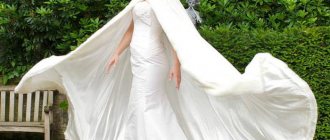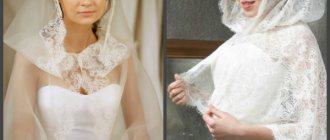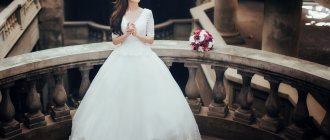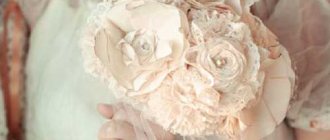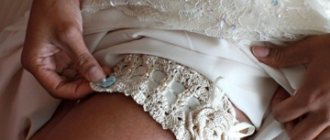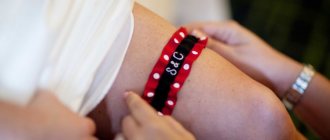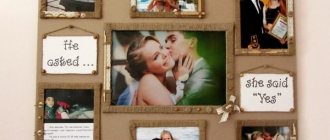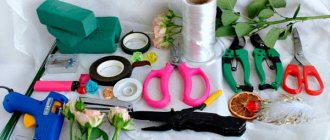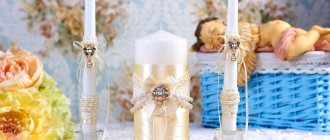When choosing clothes for a wedding, a girl should remember that she should look modest and discreet in it; one of the elements of the outfit that can help her with this is a cape with a hood, which will look elegant, but at the same time very modest.
A headdress for a bride is a special part of the outfit, because it is a mandatory attribute that must be present on a girl. Nevertheless, there are many options for this detail of the outfit and every girl will be able to choose exactly what she likes.
Varieties
A bridal cape is an accessory similar to a cloak with a hood. It can be elongated below the waistline or shortened in the form of a bolero.
The headdress is secured with ribbons or ropes in the neck area. The bolero-shaped accessory is fastened with a button or hook. Another option is a poncho - a shortened cape without fasteners with a slot for the head.
The bonnet, which covers only the head and shoulders of the hero of the occasion, is also popular among brides. Reference! To prevent the accessory from falling off the head during the wedding and not distracting the bride’s attention, the accessory is secured with decorative bobby pins or hair clips.
Depending on the weather, choose a cape with long or short sleeves. The fabric from which the accessory is sewn also depends on the season. For summer weddings, white lace hoods are the most popular. For a winter celebration, choose a cape made of thick fabrics. An alternative could be a light short fur coat, boa or jacket.
Not just a veil...
Our mothers and grandmothers are accustomed to considering mainly only a veil as a wedding accessory. But both centuries ago and today, fashionistas love to wear a lot of interesting and worthy things as additions to a wedding dress:
- bolero,
- coat,
- cape,
- neckpiece,
- poncho,
- shawl or stole,
- boa,
- coat or jacket,
- cardigan or sweater,
- raincoat or cape.
All of them are appropriate at certain times of the year, and some would be a unique charm at a themed wedding.
A bright sweater is an example of an unusual wedding cape
Choosing a stole for a dress
You can buy a wedding cape in a store or sew it yourself. When choosing an accessory for a church ceremony, it is important to ensure that it matches the bride’s outfit. This is especially true for the color scheme.
The traditional color of a wedding dress is white. It symbolizes purity and lightness. A white dress gives a special charm to the future wife. It is best to choose a cape of the same color.
Those who want to stand out choose an accessory in a contrasting color. Blue or gray capes are completely acceptable. But in this case, you should pay attention to additional accessories. They must match the color scheme of the entire image.
When choosing a cape for a wedding, you should take into account that the hood should be quite spacious so as not to hinder the bride’s movements and not disturb her hairstyle.
And some more useful tips:
- Bolero is suitable for warm seasons and dresses with open arms, neckline and open back;
- A poncho will help hide too much neckline;
- A cape-hood suits a dress with long sleeves better than others;
- Brides who want to highlight their graceful figure and maximize the beauty of their dress will love the bolero;
- If the top of the dress is decorated with voluminous details, then it is better to opt for a modest bolero with one hook clasp;
- A maximally closed cape with long sleeves looks great with a tight-fitting dress;
- A long dress with a tight-fitting skirt can be paired with either a short bolero, a hip-length cape or even a cape.
Color combinations
It is necessary to select a scarf based on the color and style of the bride’s dress. Often young ladies select all attributes separately. This is not very good, but if you have already chosen a dress, then you just need to select the remaining elements to match it.
If your wedding dress is snow-white, then the cape itself should be of a similar tone.
Please note that even white has several tones and shades, so it is better to take a dress with you to the store to choose a bonnet.
If you want to stand out, you can add some bright elements to your cape. Only two colors are considered acceptable: red and black. Red is traditional because it is depicted in Russian national costumes, and you can even wear them to enter church.
As for black, it can be noted that it is a classic color that is worthy of being used in church attire.
Wedding hood.
Color combinations in a church are a rather ambiguous task. Because you need to choose shades in such a way that in the end you get a decent combination of colors. Not too provocative and moderately strict.
Benefits of a head cap
The cape is not just beauty and a tribute to Orthodox traditions. This accessory is quite practical and convenient. In the winter season, a correctly selected piece of clothing made of dense material will warm you up; in the summer season, it will correct the too open style of the dress.
In church, girls are prohibited from appearing with open arms and cleavage. But this does not mean that you will have to give up a dress with a deep neckline, and in the summer swelter from the heat in a dress with long sleeves. A lace bolero or poncho with a hood will come to the rescue.
Important! In bad weather, the hood will not only warm the bride, but also protect her hair. At the banquet the young wife will look impeccable.
Warm fur capes for the bride on her wedding dress – Snegurochka or Snow Queen
A fur coat made of faux is considered to be a classic element of wedding outerwear in the cold winter .
Fur coat - winter outfit for the bride
But a wedding fur stole is a rather rare occurrence at our weddings. Like a fur coat, this is quite an expensive pleasure. However, wedding salons often offer to rent such accessories. A do-it-yourself fur cape for a wedding dress will also reduce the cost of holidays.
DIY fur wedding cape pattern
If the bride is a craftswoman, showing off her crafting skills on her wedding day is definitely a good idea.
A warm winter or wedding coat is a great alternative for those who want to keep warm, but do not accept fur elements in their clothes.
Wedding capes for the winter are not only part of the decor of the dress. This is to save the bride from cold and frost.
Pros of models with a hood
Newlyweds choose hooded accessories for weddings for several reasons:
- Aesthetics – the cape adds femininity and innocence to the bride’s image. This element of clothing makes any representative of the fair sex especially attractive and mysterious;
- Compliance with church canons. A wedding in a church is a special rite that believers go through. All traditions are observed in the temple, including those relating to appearance and choice of clothing. A wedding bolero will help you comply with church canons and at the same time look attractive and luxurious;
- Originality - modern brides believe that a veil is too traditional and even a banal element of clothing. Many people refuse this accessory in favor of capes.
Materials
Despite the fact that, according to church canons, rigor and conciseness are natural, you can still show your imagination a little in the image of a bride. This can be done easily with the help of the ideal selection of materials and fabric.
The most ideal options are:
- lace;
- guipure;
- shawl;
- silk;
- atlas;
- chiffon.
Remember that the hood should not look vulgar. At the same time, it is necessary to maintain a balance. So, if your clothes are decorated and decorated with rhinestones, sequins, patterns on the fabric, then the hood should be laconic, strict and simple.
Mostly for church, women choose modest and elegant dresses and decorated capes.
This is interesting: Witnesses for a wedding - are they necessary and who can be them?
You can sew beads or sequins into the cape itself. But there shouldn't be too many of them. It is extremely important to maintain balance in your look without going overboard with jewelry.
Textile
The Church welcomes modesty. However, this does not mean that a headdress made of a plain dense white fabric will be the most successful option. Even in the temple, the bride wants to look beautiful and look better than everyone else present.
A wedding cape should not be vulgar. The accessory, decorated with beads, pearls, hand embroidery, braid and other details, looks delicate.
Important! Remember a simple rule: the richer the dress is decorated, the simpler the finishing of the cape should be.
The ideal fabric for an accessory is openwork lace, tulle, satin, chiffon or guipure. The bride chooses an acceptable option, taking into account not only her own preferences, but also the wedding attire.
The fabric of the cape does not have to repeat the material from which the dress is made, but must be duplicated: in the fabric of the dress or accessories. So, a lace bolero with openwork gloves will go perfectly with a satin dress.
What is a wedding hood?
Wedding stylists strongly advise choosing the entire image for a wedding. Therefore, dresses, capes and scarves are considered inseparable. All this as a whole can create a harmonious and beautiful image of the bride.
Head cape for wedding.
No woman will be allowed to enter any church with her head uncovered. According to the commandment of the Apostle Paul, the fair half of humanity must wear a headdress as a sign of humility and submission. In church, the girl shows this obedience towards God and higher powers. Therefore, coming to the temple with your head uncovered means showing disrespect.
Girls always want to look diverse, stylish and beautiful. To do this, they select interesting accessories. If earlier women were content with simple scarves, now everything is much more complicated. Designers and stylists come up with a variety of options for brides. On the one hand, the robes look stylish and fashionable, on the other hand, they fit all church laws and canons.
A special bonnet for a wedding is a beautiful and openwork piece of fabric that covers the head, falling beautifully onto the shoulders. There are several types of capes. Some of them end just below the shoulders, while others reach the waistline. Both options are acceptable and suitable for a wedding ceremony.
A bonnet is considered a special type of cape that can cover the shoulders and head. It is quite short and performs only one function, that is, it completely covers the entire head.
The cape on the girl’s head looks light and weightless. Unlike a scarf, it does not cover the head. Accordingly, in order to avoid problems and questions during the sacrament, it is necessary to secure the bonnet to the hair with invisible ones.
This is interesting: Choosing a wedding dress together
We sew with our own hands
Sewing a wedding cape yourself is not difficult, especially if you have at least minimal sewing skills.
To begin with, choose the fabric. It can be silk, tulle, lace, guipure, but keep in mind that many of the materials are difficult to process, so choose based on your own skills and the capabilities of your sewing machine (the presence of an overlocker or other type of edge processing).
We buy additional threads for the fabric, and also think about how to make ties. These can be ribbons, braid, pearl buttons, hidden hooks, broth. You may like the option with a beautiful brooch, and then you won’t have to make a special clasp.
We offer two simple patterns with step-by-step instructions.
Option 1: with hood
- Cut out a circle whose diameter matches the size of the finished product;
- We mark the place for the neck, slightly shifting the circumference towards the chest;
- Draw the inner circle-neck;
- Cut straight from the front edge to the neckline. The cape is ready! All that remains is to make the hood;
- Fold the piece of fabric in half and mark a rectangle : width – half the circumference of the neck, length – the height of the hood (don’t forget to take into account the height of the hairstyle);
- Cut out a rectangle and attach it to the neckline of the cape;
- We trim the edges with a beautiful braid and sew on the ties.
Option 2: simple bolero
- Fold the material in half;
- We determine the dimensions based on the length of the bolero, for example, 40x55 cm with an allowance of 20-30 cm;
- We transfer the pattern to the fabric, taking into account that the upper dotted line is the cut, and the lower one is the drawstring line;
- We cut out the bolero, unfold it, and trim the edges with piping or using a decorative hem;
- On the outside, along the bottom dotted line, we sew a drawstring into which we thread a satin ribbon or a beautiful cord. You can decorate it with special end beads.
Summer capes for the bride - a midsummer night's dream
A wedding dress cape in summer is a luxurious addition to a wedding dress. It does not carry the intended purpose, but it perfectly decorates the already incomparable bride. A rather rare type of wedding cape is a boa (a flirty feather scarf). This fun accessory is perfect for a bride in a 20s style dress. Or at a wedding in the Moulin Rouge style.
Photo of a cape for a wedding dress in summer
A crocheted cape for the bride is also a great option for a summer or spring wedding dress. Choose a product with a wide, large pattern. Let it be a floral or floral ornament.
It’s a great omen if the mother or grandmother of the bride knits such a cape with her own hands.
In this case, the cape will serve not only as a delicate wedding decor, but also as a kind of blessing from relatives for a successful family life.
How to choose a hairstyle for a veil
Since your hair will be covered during the sacrament in church, you should not create something original and unusual on your head. A hairstyle for a wedding with a veil can be in the form of a low bun, loose short curls, or a loosely braided braid.
If the bride has a hood-veil for her wedding, the hairstyle options may be more varied, since the veil is additionally fixed on the neck.
The temple is not the place where you need to show originality and follow fashion. The bride, entering the threshold of the church, places herself in the hands of the Lord and begins a new life. Nothing should distract from prayer - take care of the appearance appropriate to the place and event. Willful couples planning a wedding without a veil may be denied the sacrament.
Length and number of tiers
Modern wedding salons offer a wide range of hats for brides. First of all, models are distinguished by the number of tiers. The veil can consist of only one layer or several, with one of the layers covering the face.
Interesting! According to popular belief, the longer the veil, the more prosperous family life will be.
Models vary in length:
- A short veil covers only the hair and part of the face. Suitable for any style of dress and is chosen mainly by mature brides;
- Blusher is a light single-layer veil that is attached to the back of the head and completely covers the face and neck;
- Up to the elbow - the length of the accessory is on average 65 cm. It goes perfectly with a classic dress with a full skirt, since the length of the veil ends just at the point where the skirt begins to gain fullness;
- A convenient and chaste option for a wedding is a fingertip-length veil. The accessory can be in the form of a dome, enveloping the bride on all sides, or cover only the front. The front part folds back elegantly. Consists of one or two layers;
- The ballet veil is an asymmetrical accessory: waist-length in front and reaching almost to the calves in the back;
- A floor-length sweep veil completely opens the face and is ideal for long dresses without a train;
- “Chapel” - a long veil (up to 2.5 meters) can be attached to the top of the head, but this option is not suitable for a wedding. Therefore, the accessory is placed on top of the head so that it completely covers the hair and hides almost the entire figure of the bride. Ideal for dresses with a train;
- Cathedral (cathedral) is the longest style, which simultaneously serves as both a veil and a train, reaching three meters. If the bride has chosen such an accessory, she will need the help of guests to hold her during the ceremony. This will be happily done by the children present at the wedding, who will play the role of “pages”.
How to tie a scarf for a wedding. Bride's wedding dress code
Dress. If you decide to get married not on your wedding day, then the requirements for appearance will be traditional for all parishioners. The bride should wear a low-cut dress with a long skirt that covers her knees. Trousers, transparent sundresses and sleeveless dresses are unacceptable even in summer, as well as clothes in bright colors.
If the wedding takes place immediately after the registry office, then you need to choose a wedding outfit with an eye to church norms. For a dress with a deep neckline, open shoulders or back in church, you need a light scarf, long gloves or an elegant cape - they will wonderfully complement the festive ensemble, at the same time making it modest, touching and organic to the sacrament.
In any case, the bride’s wedding dress should be light, uncolored and covering her knees, chest and shoulders. When choosing a dress with a train, keep in mind that this is a Catholic tradition, but modern clergy are unlikely to show dissatisfaction with this matter. Claims may come from witnesses who will find it very difficult to hold the crowns over the newlyweds’ heads without stepping on the hem of the dress.
It is not customary to give or sell a dress worn for a wedding. It is stored along with wedding candles, icons and baptismal shirts.
Headdress and hairstyle. It is best to check with your priest in advance whether the crowns will be put on the head or whether they will be held by witnesses: the choice of mandatory headdress and hairstyle depends on this point. If the crown is placed on the head, it is better to choose a scarf made of cotton fabric, since synthetics and silk are very slippery. The scarf is traditionally tied under the chin. If you choose a scarf with long ends or a light scarf, you can throw it over your head, cross the ends under your chin and throw it over your shoulders behind your back.
The hairstyle for a wedding should not be very high or one that is easy to crush or dishevel. The best option for a wedding headdress, when the crown is held above the head, remains a veil covering the top of the head - a combination of convenience, beauty and adherence to the canons. An elegant solution is a tiny hat. It is very important to secure the headdress well so that you do not have to adjust it every now and then during the ceremony.
Shoes. Brides are not recommended to wear high-heeled shoes to their wedding. This is the voice of reason, not customs: you will have to stand on your feet for a lot of time, it is better to take care of your own comfort, so that after the wedding the ultimate dream does not become slippers. The best shoes for a wedding are ballet flats or pumps with a small, stable heel.
Makeup. The makeup on the bride's face should be soft, natural and minimal. Women with painted lips are forbidden to kiss a crown, cross, or icon, so when entering a church you need to get rid of excess makeup. It is better to stock up on special makeup removers, as well as cosmetics for reapplication.
How to sew a cape for a wedding. A very beautiful and comfortable scarf for the temple - easy to sew!
We invite you to sew a beautiful and comfortable scarf for the temple. What are the benefits of these scarves? They do not fall off the head even when bowing, they cover the shoulders, which is important in the summer, when you want to wear a sundress, but because of the open shoulders you have to give it up, they are very beautiful and effective. This very beautiful and stylish shawl for the temple is sewn from guipure, scalloped lace fabric, simply from silk and trimmed with matching lace.
The scarves are beautiful and effective! Especially at a wedding, the bride will look incredibly beautiful in such a scarf.
How to sew a scarf for a temple
Consumption:
- With a guipure width of 140-150 cm, from 110-120 cm you will get 2 scarves;
- Lace for this size is 3-3.5 meters (for 1 scarf);
- 1.5-1.6 meters of bias tape to match;
- 1.5 m of thin satin ribbon;
- 2 end caps (or 2 beads).
This scarf was made for an adult, but my five-year-old daughter works as a model, although the scarf looks almost as beautiful on an adult.
Layout plan:
- cut the fabric (140cm wide) in half lengthwise (in advance! The picture shows a plan of the already cut half!!!)
- bend a strip of fabric along its width
- cut off one of the lower corners (see photo below)
- mark the drawstring
This is how we approximately cut off one of the lower corners on the fabric
This is after they trimmed the perimeter with lace and sewed on the drawstring (the photo, as always, is uneven), but in real life everything is smooth!
Lace and guipure are elastic, so I sewed them on a cover stitch, but you can also use a double needle
I cut off the lace at the corners, and then sewed it with a small overlapping zigzag, then cut off the excess
We sew the drawstring from the inside out, although on another scarf I sewed it from the face - it also turned out well
We thread a satin ribbon into the drawstring, and put large beads on the ends of the ribbon and tie knots
They always ask for sizes for children's scarves. Children, of course, are different, and it depends on the width of the lace with which you will trim the scarf, but here’s roughly what I drew. 80 cm of guipure will make THREE scarves.
